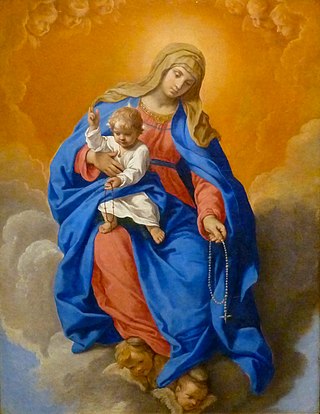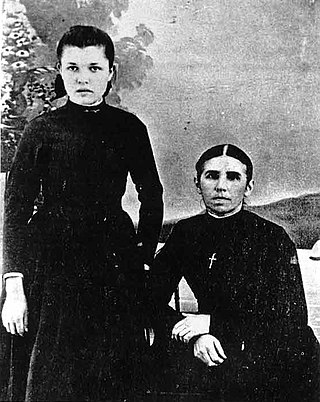
The Missionary Oblates of Mary Immaculate (OMI) is a missionary religious congregation in the Catholic Church. It was founded on January 25, 1816, by Eugène de Mazenod, a French priest later recognized as a Catholic saint. The congregation was given recognition by Pope Leo XII on February 17, 1826. As of January 2020, the congregation was composed of 3,631 priests and lay brothers usually living in community. Their traditional salutation is Laudetur Iesus Christus, to which the response is Et Maria Immaculata. Members use the post-nominal letters, "OMI".

Albert Lacombe, known as Father Lacombe, was a French-Canadian Roman Catholic missionary who travelled among and evangelized the Cree and also visited the Blackfoot First Nations of northwestern Canada. He is now remembered for having brokered a peace between the Cree and Blackfoot, negotiating construction of the Canadian Pacific Railway through Blackfoot territory, and securing a promise from the Blackfoot leader Crowfoot to refrain from joining the North-West Rebellion of 1885.

The Sisters of Charity of Montreal, formerly called The Sisters of Charity of the Hôpital Général of Montreal and more commonly known as the Grey Nuns of Montreal, is a Canadian religious institute of Roman Catholic religious sisters, founded in 1737 by Marguerite d'Youville, a young widow.

Lac La Biche is a hamlet in Lac La Biche County within northeast Alberta, Canada. It is located approximately 220 km (140 mi) northeast of the provincial capital of Edmonton. Previously incorporated as a town, Lac La Biche amalgamated with Lakeland County to form Lac La Biche County on August 1, 2007.

Sir Winston Churchill Provincial Park is a provincial park located in east-central Alberta, Canada, on the shore of Lac la Biche. The park is renowned for its birdwatching and its old-growth forests. The park consists of multiple islands in the east basin of Lac la Biche. Big Island and Long Island are connected to the shore by a causeway, with Big Island being the largest island and making up most of the park. The other islands are only accessible by boat and remain undeveloped.

The Basilica of the Sacred Heart in Notre Dame, Indiana, is a Catholic church on the campus of the University of Notre Dame, also serving as the mother church of the Congregation of Holy Cross (C.S.C.) in the United States. The neo-gothic church has 44 large stained glass windows and murals completed over a 17-year period by the Vatican painter Luigi Gregori. The basilica bell tower is 230 feet (70 m) high, making it the tallest university chapel in America. It is a contributing building in Notre Dame's historic district listed on the National Register of Historic Places. The basilica is a major tourist attraction in Northern Indiana, and is visited annually by more than 100,000 tourists.

Our Lady of the Rosary, also known as Our Lady of the Holy Rosary, is a Marian title.
The Society of Saint Pius X has close links with several religious institutes, chiefly in France.
Lac Ste. Anne is a large lake in central Alberta, Canada. It is in Lac Ste. Anne County, along Highway 43, 75 km west of Edmonton.
Henri Faraud,, a bishop of the Roman Catholic Church, was the first Vicar Apostolic of Athabasca-Mackenzie in western Canada.

The Sisters of the Infant Jesus, also known as the Dames of Saint Maur, are a religious institute of the Catholic Church originating from Paris, France and dedicated to teaching.

Located at 6, rue Notre-Dame-des-Victoires, in the 2nd arrondissement of Paris, The Basilica of Notre-Dame-des-Victoires is one of ten minor basilicas located in the Île-de-France region of France. It was begun as an Abbey church, and constructed between 1629 and 1740 in the French classical style. Its name was given by King Louis XIII, who dedicated it to his victory over the Protestants at La Rochelle in 1628 during the French Wars of Religion. Notre-Dame-des-Victoires is famous for the ex voto offerings left there by the faithful. Over 37,000 devotional plaques, silver and gold hearts, as well as military decorations, have been left at the basilica. The closest Métro station is 'Bourse'.

Île-à-la-Crosse is a northern village in Division No. 18, northwestern Saskatchewan, and was the site of historic trading posts first established in 1778. Île-à-la-Crosse is the second oldest community in Saskatchewan, Canada, following establishment of the Red River Colony in 1811. It sits at the end of a 20 km (12 mi) long peninsula on the western shore of Lac Île-à-la-Crosse, and is linked with Peter Pond Lake and Churchill Lake through a series of interconnected lakes, rivers, and portage routes.

Marie-Rose Durocher, SNJM was a Canadian Catholic religious sister who founded the Sisters of the Holy Names of Jesus and Mary. She was beatified in 1982.
The Apostolic Vicariate of Quetta, originally the Apostolic Prefecture of Quetta, is a Latin Church missionary territory or apostolic vicariate of the Catholic Church in Pakistan. It comprises the civil province of Balochistan and the Kachhi region of Punjab, Pakistan.

The Beaver Lake Cree Nation is a First Nations band government located 105 kilometres (65 mi) northeast of Edmonton, Alberta, representing people of the Cree ethno-linguistic group in the area around Lac La Biche, Alberta, where the band office is currently located. Their treaty area is Treaty 6. The Intergovernmental Affairs office consults with persons on the Government treaty contacts list. There are two parcels of land reserved for the band by the Canadian Crown, Beaver Lake Indian Reserve No. 131 and Blue Quills First Nation Indian Reserve. The latter reserve is shared by six bands; Beaver Lake Cree Nations, Cold Lake First Nations, Frog Lake First Nation, Heart Lake First Nation, Kehewin Cree Nation, Saddle Lake Cree Nation.

Onésime Dorval was the first certified teacher in the province of Saskatchewan, Canada. She was a "talented painter and innovative woodworker", and became the "best known and most respected French-language teacher" in settlements throughout the northern plains of Saskatchewan.

Émile Jean-Baptiste Marie Grouard O.M.I., "one of the most influential clerics in northern Alberta," was Apostolic Vicar of Athabasca. A gifted linguist, Grouard learned a number of languages of the indigenous peoples.













